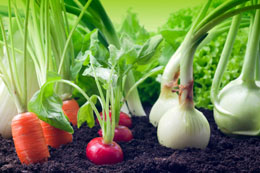There is something very satisfying about cooking vegetables that were hand picked from your own garden. This article discusses various designs and layouts of vegetable gardens and how you can choose one that is just right for your house.

There is nothing more satisfying and fulfilling than serving vegetables at dinner that you have grown in your own garden. If you have a patch of empty space in your front or backyard, you can easily grow some vegetables there. For those who live in apartments and are constrained for space, you can have your own window box or container garden.
Designs
When you are planning a garden, you need to ensure that the location you choose has enough space and receives plenty of sunlight. Vegetables flourish better in sunlight and they require good drainage too. If you have some space in your backyard, you can plan a garden that has small paths in between plots of different vegetables. This way, you can maintain the vegetables well, and it also allows for easier harvesting. Vegetables were always planted in long rows traditionally. It's a good option for planting corn and beans, but you can definitely go for some variations and create a more unique layout.
For easy accessibility, you can create a layout with raised beds instead of the traditional rows. The advantage of raised beds is that they provide better drainage, and look neater and more compact. Nothing spoils the beauty of a garden more than weeds growing haphazardly among the vegetables. You can make a three foot wide bed, with the soil about 8 to 12 inches above ground level. You can use lumber blocks or bricks to construct the beds. While deciding the plants that you want to grow, remember that there are some combinations of plants that do not work well together. Potatoes and broccoli inhibit the growth of tomatoes in a garden, and onions do not grow well with beans.
Try planting a combination of flowers and vegetables. This is visually appealing and is best for vegetables that are planted in the front yard. You can plant taller varieties of flowers―like lavender or azaleas―to make a decorative border next to a row of lettuce or cabbage. To give a rustic country feeling, you can plant some climbing roses on the fences that surround the garden. This design has a very ethereal look and the play of colors of different flowers makes an interesting contrast to the more utilitarian vegetables.
If you live in an apartment and would like to grow vegetables, then you need the garden to be small and compact. Find a spot in your house which receives the maximum amount of sunlight. This can be your balcony or a windowsill. Opt for vegetable varieties that flourish in small spaces. You can grow cherry tomatoes, cucumbers, snow peas, and pole beans that are climbers and grow vertically. Another good idea is to use containers to grow vegetables.
With a large space, you can experiment with growing different kinds of vegetables. People who live in small apartments can have a container garden and keep it on the windowsill.






 There is nothing more satisfying and fulfilling than serving vegetables at dinner that you have grown in your own garden. If you have a patch of empty space in your front or backyard, you can easily grow some vegetables there. For those who live in apartments and are constrained for space, you can have your own window box or container garden.
There is nothing more satisfying and fulfilling than serving vegetables at dinner that you have grown in your own garden. If you have a patch of empty space in your front or backyard, you can easily grow some vegetables there. For those who live in apartments and are constrained for space, you can have your own window box or container garden.